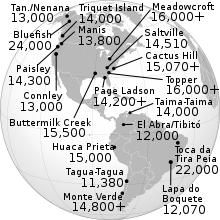Timeline of Norse colonization of the Americas
Appearance
This article may need to be rewritten to comply with Wikipedia's quality standards. (December 2020) |
Prehistoric settlement

It's widely accepted that humans first arrived by the Beringia Land bridge, some estimates claiming this occurred as early as 43,000 years ago.[1]
Norse colonization
- c. 1000: Erik the Red and Leif Ericson, Viking navigators, discovered and settled Greenland, Helluland (possibly Baffin Island), Markland (now called Labrador), and Vinland (now called Newfoundland). The Greenland colony lasted until the 15th century.
- c. 1350: The Norse Western Settlement in Greenland was abandoned.
- 1354: King Magnus of Sweden and Norway authorised Paul Knutson to lead an expedition to Greenland which may never have taken place.
- c.1450–1480s:[2] The Norse Eastern Settlement in Greenland was abandoned during the opening stages of the Little Ice Age.
References
- ^ Vachula, Richard S.; Huang, Yongsong; Russell, James M.; Abbott, Mark B.; Finkenbinder, Matthew S.; O'Donnell, Jonathan A. (2020). "Sedimentary biomarkers reaffirm human impacts on northern Beringian ecosystems during the Last Glacial period". Boreas. 49 (3): 514–525. Bibcode:2020Borea..49..514V. doi:10.1111/bor.12449.
- ^ Seaver 1996, pp. 205, 229: 205: a reference to sailors in Bergen in 1484 who had visited Greenland (Seaver speculates that they may have been English); 229: archaeological evidence of contact with Europe towards the end of the 15th century.
Other sources
- Seaver, Kirsten A. (1996). The Frozen Echo: Greenland and the Exploration of North America, Ca. A.D. 1000-1500. Stanford University Press. ISBN 978-0-8047-3161-4.
